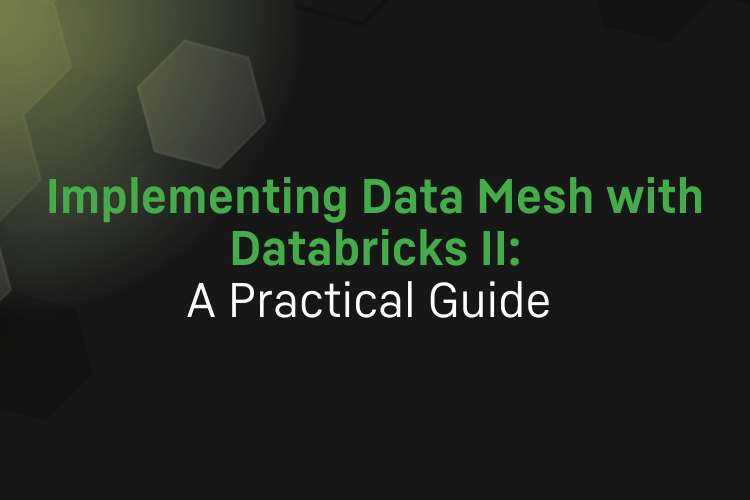by Ultra Tendency
Share
by Ultra Tendency

Let’s be honest – most of us have been there. You’re part of a data team waiting weeks for the central data platform team to process your request, or you’re a domain expert trying to explain your business requirements to someone who doesn’t quite “get” your domain. Sound familiar?
If you’ve experienced these frustrations, you’re not alone. Many organizations are hitting the same wall with centralized data architectures, and that’s precisely why Data Mesh is gaining so much traction.
What is Data Mesh?
Think of Data Mesh as applying the same principles that made microservices successful in software development, but for data architecture. Instead of relying on a single, centralized data platform that everyone depends on, you distribute data ownership across the teams that understand it best – the domain teams themselves.
Here’s the thing: your Sales team knows their data better than anyone else. They understand the nuances, the edge cases, and what “good” data looks like in their context. So why not let them own it?
Data Mesh is built on four core principles that might sound a bit academic at first, but they’re pretty straightforward:
Domain Ownership: Let the people who generate and understand the data take care of it. No more playing telephone between domain experts and data teams.
Data as a Product: Treat your data like you’d treat any other product your company ships. Provide proper documentation, set clear expectations, and ensure it works for the people using it.
Self-Serve Platform: Build infrastructure that lets teams get what they need without filing tickets and waiting in queues. Think of it as the difference between calling IT every time you need software installed versus having an app store.
Federated Governance: This one’s crucial – you want autonomy, but not chaos. Establish guardrails and standards that everyone follows, even when operating independently.
Getting Your Hands Dirty: Implementation with Databricks
Let’s walk through how this works in practice. I’ll show you how we’ve set up Data Mesh using Databricks Unity Catalog with two teams – Sales and Marketing – who need to work together without stepping on each other’s toes.
Step 1: Drawing Domain Lines
The first thing we did was create separate catalogs for each domain in Unity Catalog. This isn’t just about organization – it’s about establishing real ownership boundaries.
Here’s what we set up:
- Sales Domain: Their catalog with schemas for all their data products
- Marketing Domain: Completely separate workspace with its catalog structure
Each team gets complete control over its domain. The Sales team can evolve their data structures, add new datasets, and optimize for their use cases without worrying about breaking something for another team.
Step 2: Building Actual Data Products
Now comes the interesting part. The Sales team doesn’t just dump their data into a table and call it a day. They treat it like a product, which means adding all the context that makes it worthwhile:
- Clear descriptions that explain what the data represents
- Contact information (because someone will have questions)
- Update schedules and reliability commitments
- Access policies and usage guidelines
This metadata is what transforms a database table into something the Marketing team can actually discover and use effectively. No more guessing what order_status_code = 3 means or wondering if the data is fresh enough for their analysis.
Step 3: Governance That Works
Here’s where Unity Catalog shines. Instead of having governance as an afterthought, it’s baked right into the platform. The Marketing team can access Sales data (as they need it for their campaigns), but they cannot accidentally modify it and disrupt the Sales team’s processes.
The best part? Marketing doesn’t need to file a request, wait for approval, and then receive a CSV export via email. They connect to the data product through Unity Catalog and start working.
Advanced Features That Make a Difference
Once you have the basics down, some features make the implementation shine:
Delta Sharing allows you to share data securely without granting workspace access. This is particularly significant when working with external partners or sharing data across different security boundaries.
Data Lineage provides an end-to-end view of where your data originates and where it is ultimately used. When something breaks (and it will), you can trace the problem instead of playing detective.
What We’ve Learned
After implementing this approach, we’re seeing all four Data Mesh principles working in practice:
- Teams own their data and can make changes without coordinating with a central team
- Data has proper documentation and service level commitments
- Unity Catalog provides consistent governance without being restrictive
- Teams can find and use data independently
The biggest win? We’ve eliminated most of those frustrating waiting periods while improving data quality and governance.
The Bottom Line
Data Mesh isn’t just another buzzword – it’s a practical approach that addresses real problems most data teams face. Databricks Unity Catalog provides a solid foundation for implementing these principles without requiring you to build everything from scratch.
The key insight is this: instead of trying to centralize everything, you centralize the governance layer while distributing the actual data ownership. Teams receive the autonomy they need, without losing control or experiencing data chaos.
If you’re experiencing data bottlenecks in your organization, consider whether a distributed approach could be more effective than scaling a centralized one. Start small by picking a couple of domains that work well together and see how it goes.
The future of data architecture is distributed, and the tools to make it work are available today.




